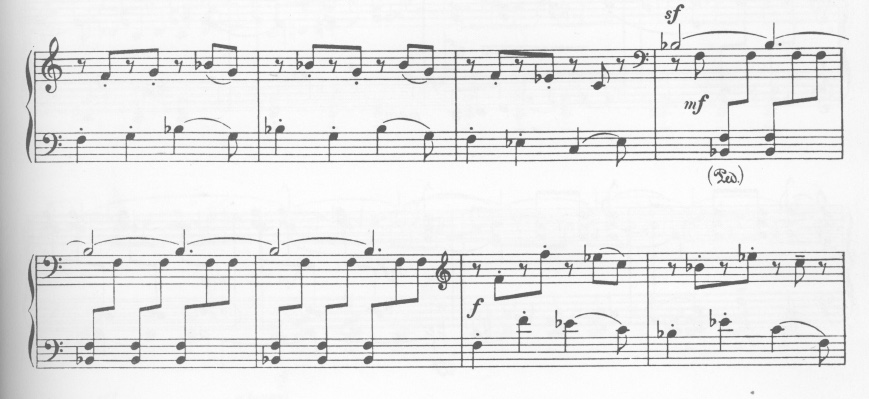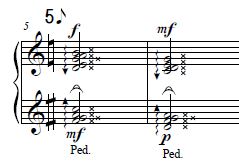Page 1 of 2
Double-dotted half note in 7/8
Posted: 15 Oct 2021, 23:11
by John Ruggero
It was proposed over at FinaleForum that a whole measure of 7/8 could be filled up with a double-dotted half note. I myself have never seen this done, only half notes tied to dotted quarter notes or vice versa as in the following example. What do other Notatio members think about this? Would you fill a 7/8 measure with a double-dotted half note and why or why not?

- Copland Piano Sonata.jpeg (56.23 KiB) Viewed 5027 times
Re: Double-dotted half note in 7/8
Posted: 16 Oct 2021, 08:16
by NorFonts
Well, for me I'd do the same notation or vice-versa, I mean depending of the way you count the ⅞ : 3 + 4 or 4 + 3, so the example above tells you that you've 4/8 =one-half note figure and the ⅜ = a quarter note figure with a dot... I used to do it many times with my jazz compositions, and especially when I transcribe Moroccan, Algerian, Balkan and Turkish music.
Re: Double-dotted half note in 7/8
Posted: 16 Oct 2021, 09:23
by David Ward
I don't remember ever encountering the double dot notation for a whole bar in 7/8; but then why not? It's meaning would be clear plus it reduces clutter.
Re: Double-dotted half note in 7/8
Posted: 16 Oct 2021, 12:45
by John Ruggero
Thanks NorFonts. So I take it that you would prefer to do it as in the example and not with a double-dotted half note. Why?
David, I've never encountered it either. I was interested to see if anyone else had.
Re: Double-dotted half note in 7/8
Posted: 16 Oct 2021, 18:09
by NorFonts
John Ruggero wrote: ↑16 Oct 2021, 12:45
Thanks NorFonts. So I take it that you would prefer to do it as in the example and not with a double-dotted half note. Why?
David, I've never encountered it either. I was interested to see if anyone else had.
I think that the players want things to be more clear on the score, as I explained you, for me notating it as 3+4 or 4+3 is more clear than having only a double-dotted hand note, even this one is mathematically and as notation correct!
Re: Double-dotted half note in 7/8
Posted: 16 Oct 2021, 19:19
by David Ward
Wouldn't that depend upon the circumstances? When I played (too old now: 80), if I had one note to sound for a whole bar (not rare on bass trombone) I think I might have rather liked to have seen just one note, double dotted, rather than two notes tied. Either way, I'm fairly sure I never actually encountered it, but I certainly met 7/8 (and indeed fractional time signatures plus Messiaen's curious 3 2 3 4 /32 and the like). One got used to counting almost anything doable and coped as long as the one in charge WAS in charge.
Re: Double-dotted half note in 7/8
Posted: 16 Oct 2021, 20:51
by PGLaouto
Greetings from Brisbane, Australia!
I have seen a double-dotted half note filling a measure in 7/8 on many occasions.
I would say the context determines whether it's appropriate.
In your example John, I wouldn't use a double-dotted note, as you're constantly changing meter, and seeing the 2+2+3 (or 4+3) as it shows in your example is very helpful - essential even.
If however, you had a piece in 7/8 where it was always 3+2+2 (or all 2+2+3), it seems to me just as valid to fill a measure with a single note as it would to use a dotted half-note in 6/8. Another example would be in a rhumba in 4/4 (3+3+2) - a note taking up a whole measure would still be a whole-note, right? (Not two dotted-quarters tied to each other and then to an undotted quarter-note).
Several of the groups I play in use predominantly irregular meters like these, in Balkan/Turkish/Arabic derived or inspired original compositions - in a genre known as Contemporary Modal Music, and if you're playing in a constant (though irregular) meter and you're improvising a solo, you have to be "feeling" the beat in the same way that one "feels" 4/4 or whatever other time-signature.
Re: Double-dotted half note in 7/8
Posted: 17 Oct 2021, 03:43
by John Ruggero
I agree with all the points that have been made. For me seeing the 4 + 3 or 3 + 4 in the held note is clearest. Yet, as PGLaouto says, in a piece with an unchanging 7/8, using a double-dotted half note would be a lot simpler and, as David Ward pointed out, less cluttered. And apparently it is actually being used in current music.
Despite this, up to now, the double-dotted notation may not have been standard even in this latter situation. Here is an example from Bartok's Dance in Bulgaria Rhythm no. 2 which is entirely in 2 + 2 + 3/8 meter:

- Bartok Bulgarian Rhythm no 2.jpeg (106.59 KiB) Viewed 4966 times
Perhaps the reason for this is that formerly, double-dotted notes (or rests) only appeared in situations where they were completed by another note or rest to form a undotted value like a quarter, half or whole note. So, for example, a double-dotted eighth note would always be followed or preceded by a 32nd note or rest to add up to a quarter note. Chopin even used a triple-dotted half note in conjunction with an 16th note to fill out a 4/4 measure (Prelude in G from op. 28). Earlier composers didn't think of a double- or triple-dotted note as being self-sufficient, like a single-dotted note in compound time, and therefore didn't use it to fill an entire measure.
I think that I would only use a double-dotted half note to fill up a 7/8 measure if the the piece were in an
unsubdivided 7 beats per measure since there subdividing into 4 + 3 etc. would give a misleading impression.
Re: Double-dotted half note in 7/8
Posted: 10 Dec 2021, 12:35
by Anders Hedelin
John Ruggero wrote: ↑17 Oct 2021, 03:43
I think that I would only use a double-dotted half note to fill up a 7/8 measure if the the piece were in an
unsubdivided 7 beats per measure since there subdividing into 4 + 3 etc. would give a misleading impression.
While the double-dotted note may be useful for the reason mentioned by John, it only works for 7/x measures, not for 5/x ones. The following is an attempt to fill out that gap in traditional rhythmic notation:

- x-dots.JPG (17.03 KiB) Viewed 4005 times
"x-ing" a note adds a quarter of its value, x being half a dot. (We might be grateful to the inventor of this notation that he/she didn't decide on literally
half dots).
Re: Double-dotted half note in 7/8
Posted: 11 Dec 2021, 15:04
by Anders Hedelin
I think we had a discussion about notational innovations before, concluding that if they are not widely accepted they are not to be taken too seriously. Or at least not as any kind of rules.
Now, I happen to think that this innovation (the "x dot") is both ingenious and useful, and can only hope that it would become more widely acknowledged. Of course, its possible use would be restricted to music composed from now on. It wouldn't do to apply it to music already written - if not by composers themselves.